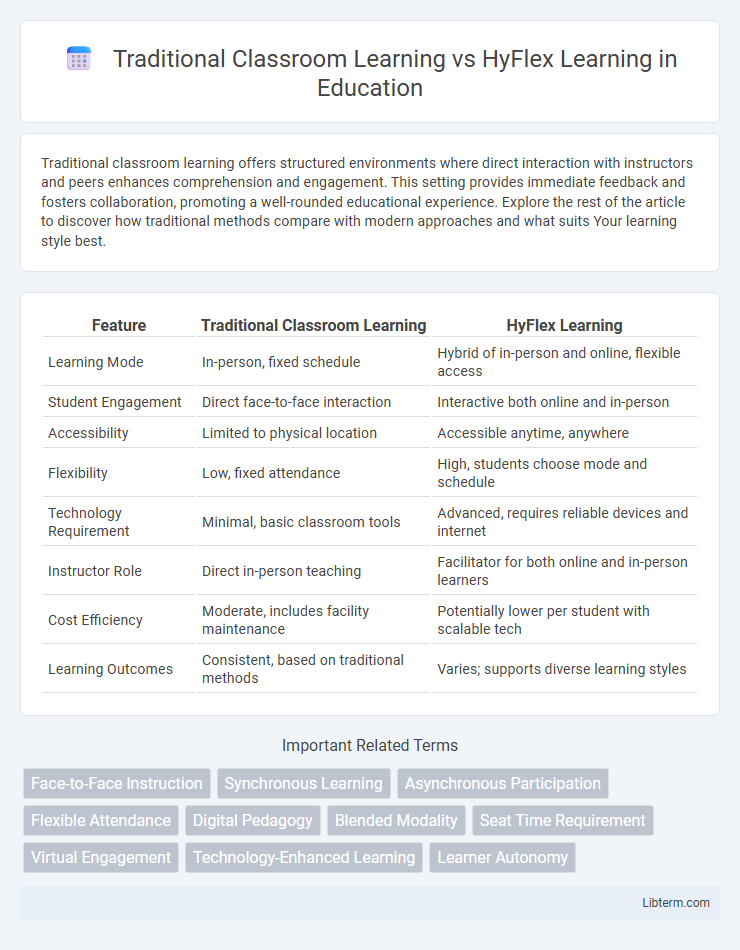Traditional classroom learning offers structured environments where direct interaction with instructors and peers enhances comprehension and engagement. This setting provides immediate feedback and fosters collaboration, promoting a well-rounded educational experience. Explore the rest of the article to discover how traditional methods compare with modern approaches and what suits Your learning style best.
Table of Comparison
| Feature | Traditional Classroom Learning | HyFlex Learning |
|---|---|---|
| Learning Mode | In-person, fixed schedule | Hybrid of in-person and online, flexible access |
| Student Engagement | Direct face-to-face interaction | Interactive both online and in-person |
| Accessibility | Limited to physical location | Accessible anytime, anywhere |
| Flexibility | Low, fixed attendance | High, students choose mode and schedule |
| Technology Requirement | Minimal, basic classroom tools | Advanced, requires reliable devices and internet |
| Instructor Role | Direct in-person teaching | Facilitator for both online and in-person learners |
| Cost Efficiency | Moderate, includes facility maintenance | Potentially lower per student with scalable tech |
| Learning Outcomes | Consistent, based on traditional methods | Varies; supports diverse learning styles |
Understanding Traditional Classroom Learning
Traditional classroom learning involves face-to-face instruction where students and teachers interact within a physical classroom setting, promoting direct engagement and immediate feedback. This method emphasizes structured schedules, in-person collaboration, and hands-on activities that foster social interaction and collective learning experiences. Despite advancements in technology, traditional learning remains a foundational educational approach known for its effectiveness in building discipline and interpersonal skills.
What Is HyFlex Learning?
HyFlex learning combines traditional face-to-face classroom instruction with online asynchronous participation, allowing students to choose their mode of attendance. This flexible approach integrates synchronous and asynchronous elements, enabling real-time interaction and independent study tailored to individual learning preferences. HyFlex models enhance accessibility and student engagement by accommodating diverse learning styles and schedules.
Flexibility in Learning Modalities
HyFlex learning offers unparalleled flexibility by allowing students to choose between attending classes in person or participating remotely through synchronous online sessions, accommodating diverse schedules and learning preferences. Traditional classroom learning typically requires physical presence, limiting accessibility for students with varying commitments or geographic constraints. HyFlex models leverage digital platforms and recorded lectures, enabling learners to switch seamlessly between modalities without disrupting their educational progress.
Student Engagement: Face-to-Face vs. HyFlex
Traditional classroom learning fosters direct, real-time interaction, promoting higher student engagement through immediate feedback, collaborative discussions, and hands-on activities. HyFlex learning offers flexibility by combining in-person and online participation, allowing students to choose their mode while maintaining access to course materials and live engagement opportunities. Studies indicate that while face-to-face settings enhance social presence, HyFlex models increase accessibility and accommodate diverse learning preferences, potentially improving overall engagement when effectively managed.
Technology Integration in HyFlex Classrooms
HyFlex classrooms leverage advanced technology integration such as interactive video conferencing, learning management systems, and real-time collaborative tools to facilitate simultaneous in-person and remote learning. This technological infrastructure enables seamless communication, personalized learning experiences, and flexible access to course materials, surpassing the static nature of traditional classroom settings. The incorporation of digital platforms enhances student engagement and supports diverse learning preferences through synchronous and asynchronous participation.
Accessibility and Inclusivity Compared
Traditional classroom learning often faces challenges in accessibility due to fixed location and time, limiting participation for students with disabilities, remote learners, or those with scheduling conflicts. HyFlex learning models enhance inclusivity by offering simultaneous in-person and online participation options, accommodating diverse learning preferences and needs. This flexible structure supports equitable access, fostering a more inclusive educational environment for all students regardless of physical or geographical barriers.
Instructional Design: Traditional vs. HyFlex
Traditional classroom learning relies on fixed, in-person instructional design focused on direct teacher-student interaction and structured schedules, emphasizing face-to-face engagement and immediate feedback. HyFlex learning incorporates flexible instructional design combining both synchronous in-person and online modalities, enabling learners to choose their mode of participation while ensuring consistency in content delivery and assessment. Effective HyFlex instructional design prioritizes technological integration, adaptable course materials, and learner autonomy to support diverse learning preferences and enhance accessibility.
Role of Instructors in Both Models
In traditional classroom learning, instructors primarily deliver in-person lectures, facilitate face-to-face interactions, and provide immediate feedback to students. HyFlex learning requires instructors to design flexible course content that accommodates both remote and on-campus learners simultaneously, demanding proficiency in digital tools and multitasking during live sessions. Effective instructor roles in both models hinge on fostering engagement, adapting communication strategies, and ensuring equitable learning experiences across diverse formats.
Assessing Student Outcomes and Performance
Assessing student outcomes in Traditional Classroom Learning primarily relies on in-person evaluations such as timed exams, quizzes, and direct teacher observations, which provide immediate feedback but may lack flexibility. HyFlex Learning incorporates both synchronous and asynchronous assessments, enabling diverse methods like online quizzes, discussion forums, and multimedia projects that cater to varied learning styles and schedules. Data from HyFlex models often reveal improved engagement metrics and comparable or enhanced performance outcomes, highlighting the adaptability of assessment strategies in hybrid educational environments.
Future Prospects: Evolving Educational Paradigms
Traditional classroom learning remains valued for structured engagement and direct social interaction, but HyFlex learning models are gaining traction due to their adaptability and personalized learning experiences. The future of education increasingly leans toward integrating technology-driven HyFlex systems that blend synchronous and asynchronous modalities, accommodating diverse learner preferences and access needs. Emerging educational paradigms emphasize hybrid flexibility, leveraging digital tools and data analytics to enhance curriculum delivery and foster inclusive, scalable learning environments.
Traditional Classroom Learning Infographic

 libterm.com
libterm.com